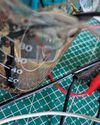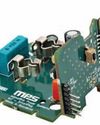When To Use Free Or Open Solutions For AI
Electronics For You
|June 2023
There are many free and open platforms and tools for developers of AI solutions. Should you go for them, or avoid them?

Today artificial intelligence (AI) systems are everywhere. They can do a lot of unbelievable things, like predicting behaviour and patterns.
Many big tech companies are integrating AI into their hardware as well. Apple has incorporated it into its chips to perform various machine learning (ML) operations. Even graphical processing units today are having some form of AI integrations for improved performance within them, which was not the case a few years ago.
AI comes at a cost
But AI does not come cheap. We have been using classical AI for a while now. But with the emergence of neural networks, things have changed drastically. We have reached a point where you can just put a prompt and generate images straight out of your imagination.
Neural networking was discovered twenty years ago and the reason it worked back then is computation. Adding computational layers back then was not easy and required a huge cost to implement, but that is not the case today.
Machine learning is highly mathematically intensive and requires a lot of statistical knowledge. Applying artificial intelligence solutions is not a child’s play as it requires you to study every aspect of it thoroughly. Only then will you be able to make those models and apply them.
It is not an easy task to learn tools like Tensorflow and Kiras to spin up your own servers, and that is where we need free and open AI solutions. There was a time when using ML solutions was not so easy either, as it required a lot of steps to be followed. Thankfully, that is not the case today as you can pick the model that suits your needs the best to work on.
DNA fragmentation index
Dit verhaal komt uit de June 2023-editie van Electronics For You.
Abonneer u op Magzter GOLD voor toegang tot duizenden zorgvuldig samengestelde premiumverhalen en meer dan 9000 tijdschriften en kranten.
Bent u al abonnee? Aanmelden
MEER VERHALEN VAN Electronics For You

Electronics For You
Tech Majors Are Racing TOWARDS NET-ZERO - What About You?
Apple, Microsoft, Amazon, Google, Infosys, Wipro—global and Indian firms are heading closer to achieving net-zero emissions, a mandate to combat climate change. Here is what you need to know to start your journey...
12 mins
December 2025

Electronics For You
Miniature IoT WATER TDS And LEVEL MONITOR Cum CONTROLLER
For setups that rely on stored water, clear awareness of tank level and water quality is essential.
3 mins
December 2025

Electronics For You
The Impact Of GENERATIVE AI On The Future Of AUTOMOTIVE AND EVs
Autonomous vehicles, connected ecosystems, and smart factories are only the beginning. Generative Al is pushing the auto industry beyond predictions into a bold era of creativity-from EV design to real-time diagnostics and showroom automation. Here is how GenAl is reshaping innovation across the automotive value chain.
8 mins
December 2025

Electronics For You
How AI Tools Are Making SOFTWARE DEVELOPMENT BETTER
AI is reshaping how we code, debug, and collaborate. From Copilot to automation, it is changing software development in ways worth exploring.
3 mins
December 2025
Electronics For You
How AI Tools Are Making SOFTWARE DEVELOPMENT BETTER
AI is reshaping how we code, debug, and collaborate. From Copilot to automation, it is changing software development in ways worth exploring.
3 mins
December 2025

Electronics For You
5 Interesting Reference Designs FOR SMART HOMES
Smart home devices are transforming the way people interact with their appliances. They make homes more convenient, secure, and energy-efficient. From smart plugs and energy monitors to smart locks and thermostats, reference designs help design engineers create connected products that are easy to use, consume less power, and are reliable. These designs allow you to control devices remotely, track energy use, extend battery life, and automate routines. They provide practical solutions for upgrading homes and small commercial spaces without major modifications.
3 mins
December 2025

Electronics For You
Fancy USB LED VASE
This USB LED vase is a simple yet elegant device that fuses art with electronics to create a decorative lighting display. Powered directly from a standard USB port, it uses readily available components such as MOSFETs, resistors, capacitors, and LEDs to produce a striking, dynamic sequence of lights.
3 mins
December 2025

Electronics For You
"WHAT OTHERS SELL IN FOUR BOXES WE BUILT IN ONE"
Years of custom field work are shaping a product line with its own cloud, its own hardware, and a market that is now beginning to recognise its value.
8 mins
December 2025

Electronics For You
BUILD LARGE LANGUAGE MODELS
Large language models are machine learning models designed for a range of language-related tasks such as text generation and translation. Here’s how open source software can help you build your own large language model.
6 mins
December 2025

Electronics For You
Rare Earth Or Rare Ingenuity? India Remains Between The Two
With China firmly controlling rare earth exports, India confronts a critical moment in its technological trajectory.
8 mins
December 2025
Translate
Change font size

